Part of a series of articles titled Grand Canyon Centennial Stories.
Article
1914 Metz Car

Through the Grand Canyon in 1914
To the Colorado River in a Metz 22 Speedster
By O.K. Parker, Reporter, Los Angeles, CaliforniaTo the bottom of the Grand Canyon by automobile was probably the most strenuous undertaking ever carried out in the annals of American motoring. To make that trip and to return to the plateau thousands of feet above, all on the car's own power, negotiating deep sand arroyos, frightfully steep grades, great boulder filled gorges and slimy mud flats, is a feat extraordinary.
Yet it has been accomplished by Mr. L. Wing, of the Metz Agency in Los Angeles, accompanied by the writer in a 22 horsepower Metz car of the roadster type.
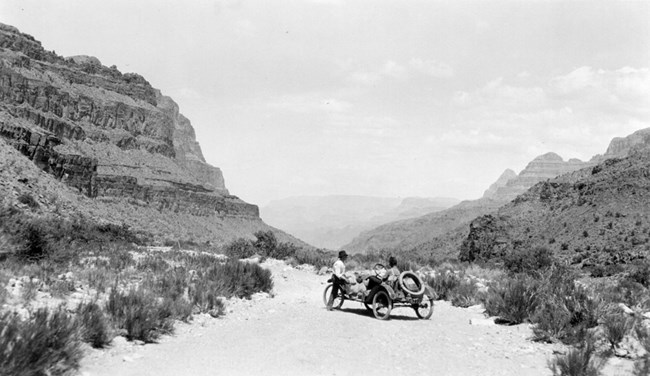
The gorge from Peach Springs cuts down through the plateau, deeper and deeper, until its walls join those of the main gorge, through which the Colorado River forces its turbulent way, nearly a mile below the level of the surface above. The entire route from Los Angeles to Peach Springs, where the descent into Grand Canyon actually commences, is through the sand deserts south of Death Valley, and across the Colorado River, at Needles.

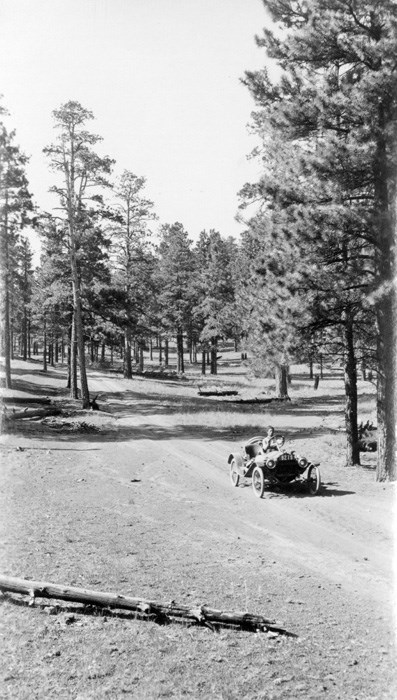
This combination of mountains, deserts, sands and lava, makes the road a difficult one to travel, and demonstrates the real power and dependability of a car. Once a test like this is successfully passed, the motorist feels that his machine has the stamina to tackle even the dreaded gorge on the way to the bottom of the Grand Canyon.
Before making the descent, we wanted to drive the car to the rim of the canyon, so we took the conventional route through the pine forest to the Bright Angel Trail and the El Tovar Hotel, 587 miles from Los Angeles and sixty-five miles from Williams, AZ

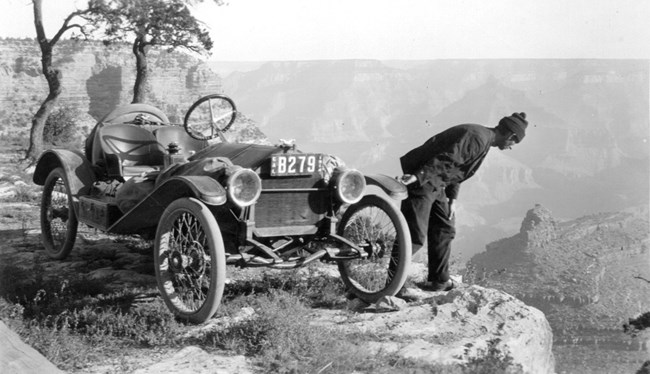
It took a lot of grit to drive the car right towards that fearful plunge, but Mr. Wing, who handled the wheel, had every confidence in the car and its control, and did not put on the breaks until the front wheels were right at the very edge of the precipice.
I confess that it made me shudder with apprehension, as I watched him, so cool and confident, driving where one little slip would mean a plunge of two thousand feet into the gorge below; and when he finally said, " that will do, let's chuck block her," I was only too glad to slip a good sized rock in front of the rear wheel, so we could leave the car and size up the situation for a photograph.
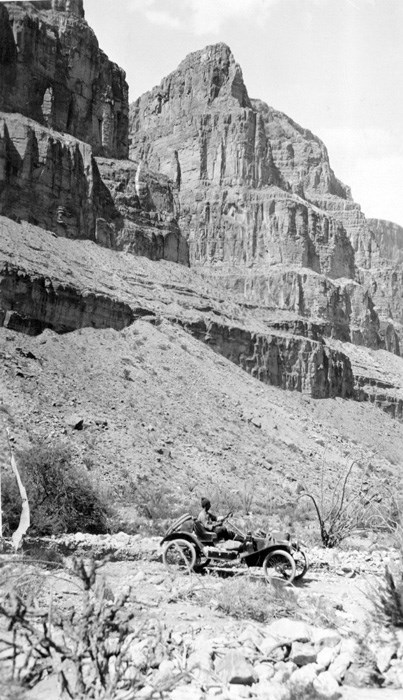
After a day spent at the Canyon's rim, where we camped near the Bright Angel Trail, we drove back to Williams, and then to Peach Springs, for the final test of the stability of the car in negotiating the downward trip to the bottom of the Canyon.
That night, as we talked of the struggles through and over the rocks and sands that must be made next day in getting down Peach Springs Gorge and Diamond Creek. We speculated on our chances of getting through without accident, and, to safeguard our return, in case the car should fail us, we arranged with Mr. Willetts, Superintendent of the Hualapai Indian Reservation, that if we did not return the second night he was to send an Indian and two extra saddle horses, together with a little emergency grub, to meet us wherever we might be stalled in the Canyon.
As it turned out, however, as strenuous as the trip was, we had no occasion or need for other that the cars own power; and while it took us a whole day to make the downward trip, and another day to get back up to the plateau, we made the journey and returned to Los Angeles without so much as breaking a single part.
The total distance traveled from Los Angeles and return was approximately 1,400 miles; and the actual descent into the Grand Canyon, and the climb back to the surface, consumed 42 miles. It might be truthfully said that every foot of this distance was rough going, yet not a single adjustment to the car was necessary. Never did we use a wrench to tighten a bolt or nut. To describe our trip in detail, to the bottom of the Canyon, would fill a whole book. What I wish to bring out, as a matter of most interest to drivers of cars, and the intended purchasers of cars, are some of the obstacles we had to contend with. In places, the bed of the wash became so narrow that the car would not pass through, so we were obliged to back up, sometimes several hundred yards, until we found a place where the car could pull itself up out of the bed of the wash.
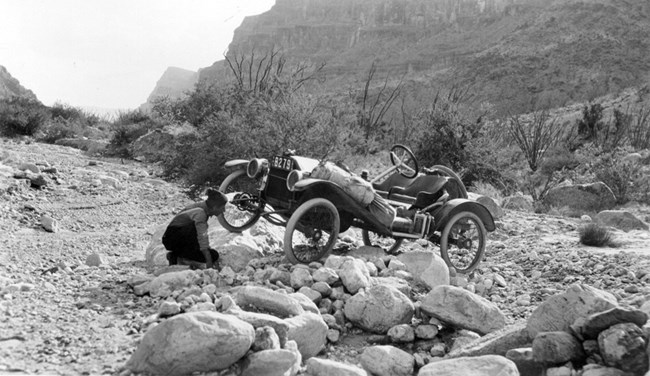
mark the accumulation of ages.
After passing these narrow points we were, of course, obliged to drop down into the wash again, and frequently encountered boulders that had become blocked in the bed of the wash, and piled up, presenting an obstacle formidable enough to discourage the stoutest heart - and you would think - to put out or commission the toughest car. But the way our Metz climbed over that stuff was almost unbelievable, now as I think back on it.
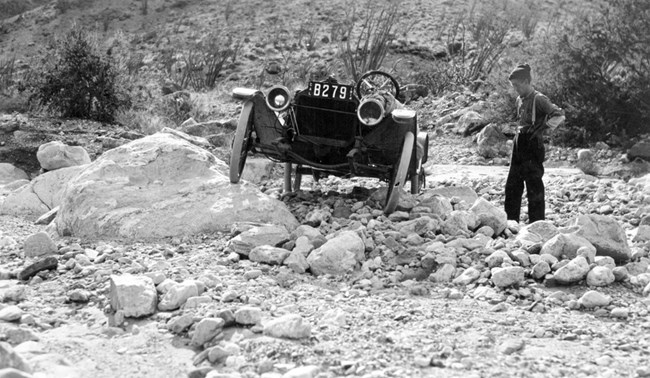
The twisting and straining of the axles, springs and frame of the car was almost beyond the endurance of steel. For an example of extreme flexibility, one can hardly equal it.
At times, the car forcing its way over those big piles of boulders, became so distorted that the rear wheels would be tilted at an angle of 30 degrees in one direction, while the front wheels were tilted at an angle of 20 or 30 degrees in the opposite direction. A bigger heavier car would never have withstood the strain.
During this whole distance of seventeen miles from pump house to the river, it was one continuous fight against obstacles, which on an ordinary country road would have immediately been judged impassable.
Darkness overtook us when we were still one and one-half miles from the bottom of the Canyon. We camped here for the night, and some night it was! About 10:30 it began to rain, and within a few minutes we were drenched to the skin by one of the severest thunderstorms I have ever seen.
It was a fitting end to a day of great effort to overcome nature's obstacles. It seemed as if Nature herself was trying to punish us for attempting to invade her virgin pastures with a modern Roadster speed devil.
But at daybreak we were at it again, and from this point on we had one more foe to conquer - quicksands. Just beyond our camp Diamond Creek empties into the wash, and turns its bed in many places into bottomless quicksands. Here caution was to no avail, rapid action was imperative.
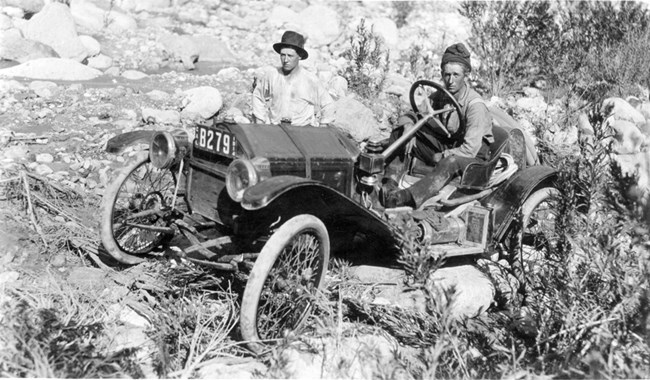
There was one point in the last mile that seriously threatened us with defeat. In front of us lay a group of big boulders, each several times bigger than the car itself. There was no way around the obstacle. The big gaps between the boulders were impassable. But the Colorado River was almost in sight - we couldn't loose now! With the strength of despair we carried smaller boulders, and rolled bigger ones, into those gaps, and then piled bushes and anything we could get hold of, on top of them, to make a path for the car to climb over.

We reached the river at eleven o'clock in the morning and dipped our wheels into it before starting back.
Our experiences stood us in good stead upon the return trip and we made remarkable time. The car showed to great advantage on the hills and negotiated them with an ease and sureness that surprised even we two who had become rather injured from witnessing each achievement of the car on the downward trail.
Now, instead of being experimenters, so to speak, we were tourists, and I can assure you we keenly enjoyed the exhilarating trip to the top, and it was with no little satisfaction that we looked back from each new height gained with the thought that we were probably the first to make the trip in this way.
Our experiences stood us in good stead upon the return trip and we made remarkable time. The car showed to great advantage on the hills and negotiated them with an ease and sureness that surprised even we two who had become rather injured from witnessing each achievement of the car on the downward trail.
Now, instead of being experimenters, so to speak, we were tourists, and I can assure you we keenly enjoyed the exhilarating trip to the top, and it was with no little satisfaction that we looked back from each new height gained with the thought that we were probably the first to make the trip in this way.
Last updated: August 9, 2018
